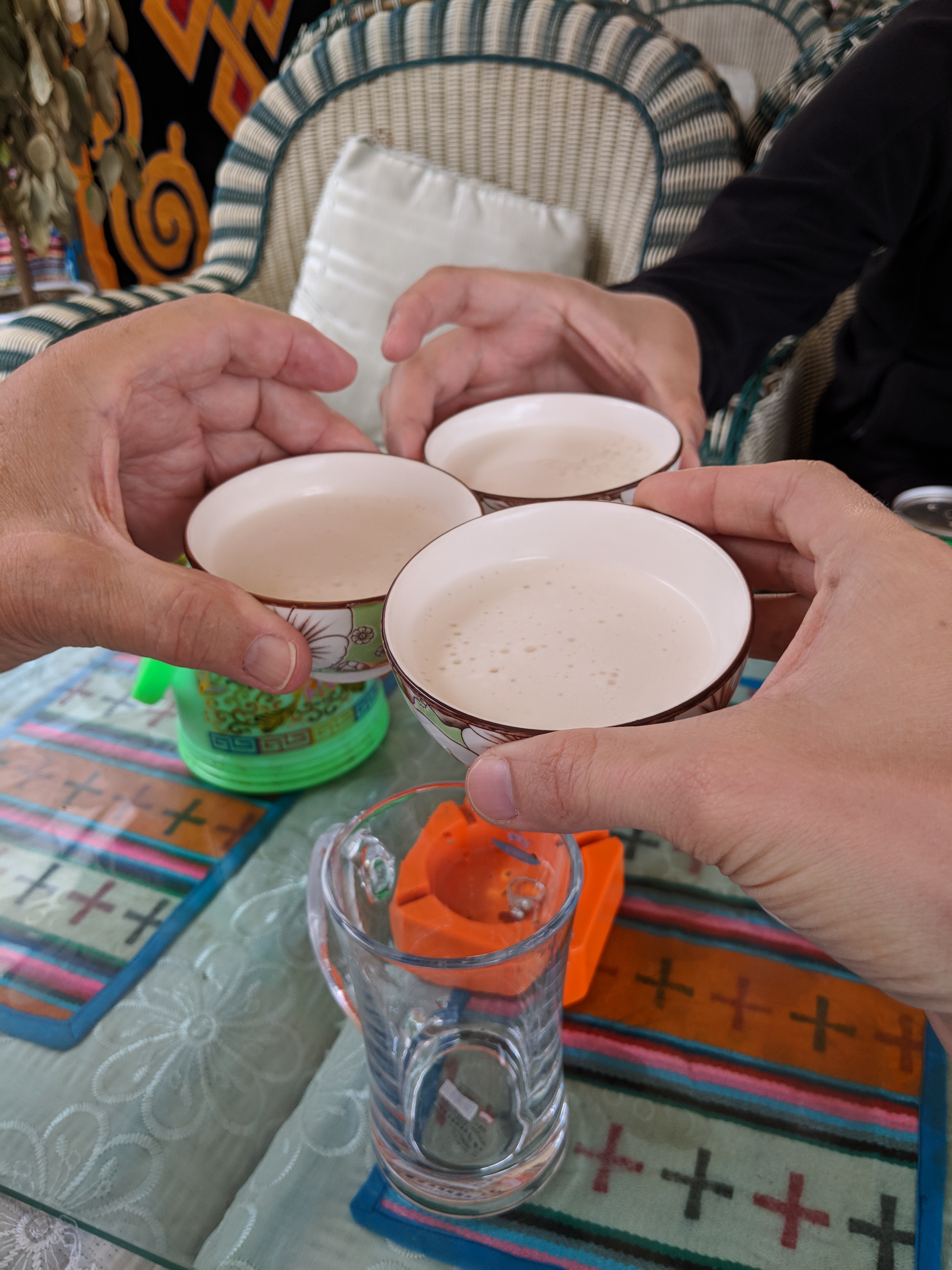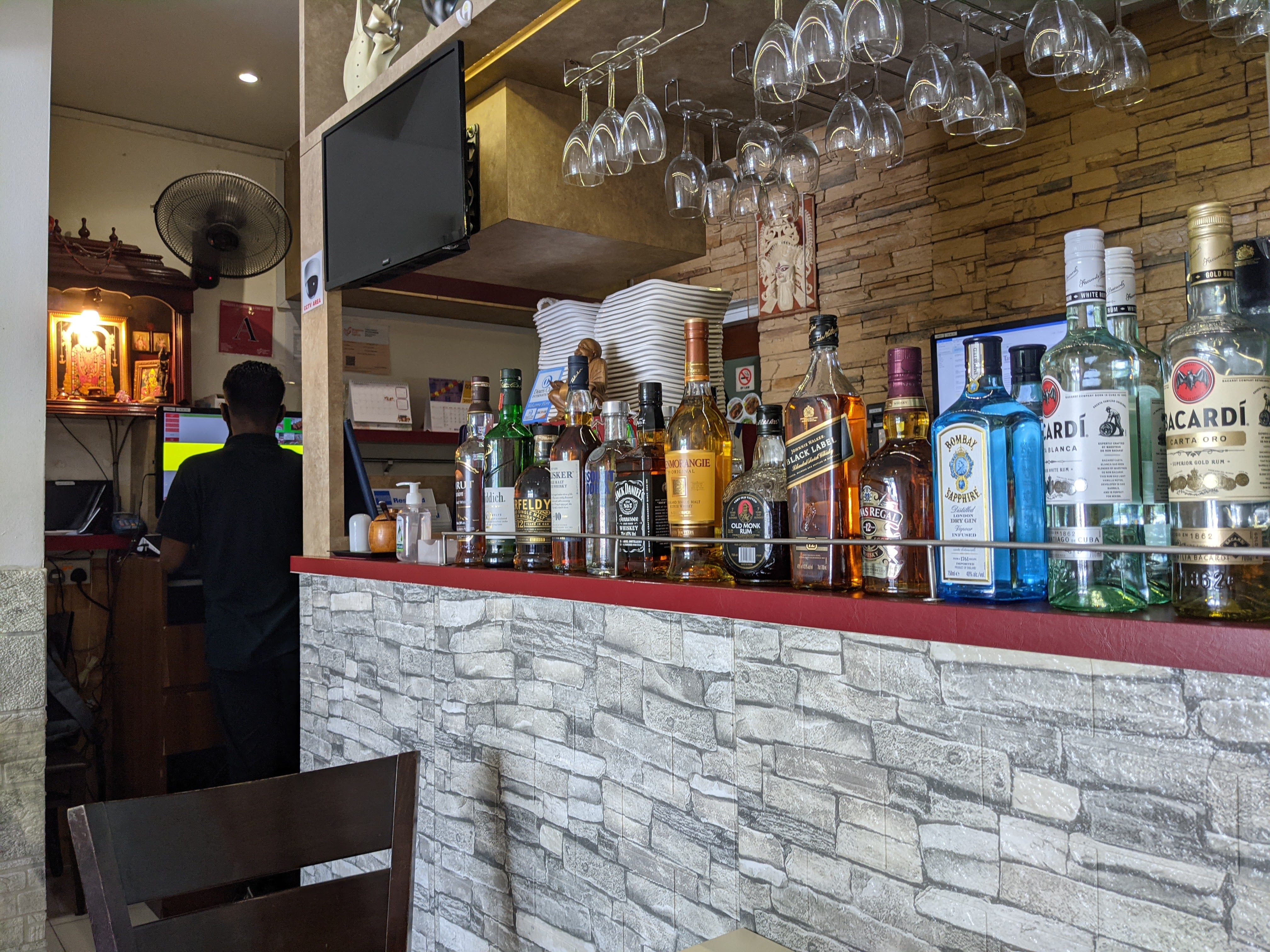The final long-distance train of our journey was also the nicest. Few of China’s trains are branded, but the Tangzhu Ancient Route (唐竺古道号) from Xining to Shigatse via Lhasa had been bestowed its label only a few months before our trip and the entire train was decked out with pretty, purple-tinged Tibetesque frippery, down to the vase of plastic violet roles on our table.
We left Xining in the evening and slept through the slow climb up the plateau, crossing the 5,072m Tanggula Pass — the highest stretch of train track in the world — conveniently after breakfast. The combo of acclimatization, a precautionary course of Diamox (acetazolamide) and the oxygen being piped into all the cabins worked a treat, and none of us felt more than the faint echo of a headache.
Arrival into Lhasa, at “only” 3,656m, was somewhat anticlimactic. The station is located on the newly built, heavily Chinese-flavored west side of Lhasa. Our Tibet permits were scrutinized for the fourth time on this ride (rest assured, sneaking into Tibet is not a thing any more), our mandatory guide was waiting our mandatory van, and we drove through what felt very much like just another Chinese city, full of construction sites, shiny glass-fronted buildings, and the odd concrete building or bridge tarted up with some Tibetan detail, already fading and peeling off after a few years.
And then we arrived in the old city around Barkhor and stepped back in time a thousand years. The penetrating funk of yak butter wafted around the narrow, twisty streets (we would soon come to realize that this was the smell of Tibet, in much the same way that boiled mutton is the smell of Mongolia), shops sold dried cheese, fresh yak meat and temple offerings, our hotel the House of Shambhala was decorated with near-Indian amounts of color and statuary, pilgrims prostrated themselves as they circumambulated the temple of Jokhang… this, emphatically, was not China.
It is difficult to write about Tibet as an outsider. For the Tibetan exiles who supply Free Tibet bumper stickers to soccer moms in Berkeley and the predominant Western view of the country, the Chinese presence is nothing short of a violent occupation intent on reducing their country into a theme park, and it’s hard to disagree with this. But from the Chinese point of view, the army liberated Tibetans from an oppressive absolute theocracy, where a tiny elite of lamas ruled teeming masses of miserably poor serfs, and brought in modernity and economic development — and it’s hard to disagree with this either, particularly after having visited the Tibetan exile capital of Dharamsala and witnessed the lethal roads and Indian squalor of the settlement. The excesses of the Cultural Revolution, when the Chinese government straight up razed everything that didn’t fit the program, have long since been dialed back and at a casual glance, it even looks like China is actively supporting Tibetan culture now. Every single road and shop sign had Tibetan script above the Chinese, albeit often in an illegibly small font, and vast amounts of money have clearly been pumped into tidying up the once-decaying old city.
All that said, it was still clear that this is a land that the Chinese government keeps in an iron grip. Security checkpoints and CCTV cameras dotted entrances not just to train stations and museums, but to Barkhor and the city itself, and it wasn’t enough to show your bags, you had to scan your ID as well. Many guards and low-level police were Tibetan, but the heavily armed riot squads stomping around the Old City were all Han Chinese. Lighters were banned and fire extinguishers prominently placed in any spot where a self-immolation might lead to bad publicity. The few Tibetans we had a chance to talk to spoke in stage whispers if offering politically incorrect opinions (“The Chinese are like rats! They’re everywhere!”). Political propaganda, a subdued presence on the streets of Beijing but more visible in Xining, was pumped to a fever pitch here, with fervent invocations of Prosperous Strength (富强 fùqiáng) and Harmony (和谐 héxié) . Even posters of Xi Jinping, which nearly disappeared from the rest of the country during our visit, could be found in abundance. And in the center of town, roped off in the middle of a heavily guarded square, stands the Monument to the Peaceful Liberation of Tibet, raising a permanent middle finger towards the Potala Palace opposite. Subtle it was not, and you can only wonder if even Party apparatchiks genuinely believe this kind of thing will convince any Tibetans of the errors of the Dalai Lama’s splittist ways.
The Potala Palace is still standing though, its simultaneously graceful yet fearsome hilltop bulk dominating the city like few ancient structures still can. In its own way, it was much like Beijing’s Forbidden City, only now with supplicants climbing up endless flights of stairs to experience the spiritual wisdom and earthly power of Tibet’s former god-kings. Today they’re long gone and the supplicants have been replaced by tour buses of Chinese tourists, with tours of the interior limited to a choreographed controlled 60-minute dash and interior photography strictly forbidden.
The heart of Lhasa for Tibetans is the comparatively modest temple of Jokhang — although “modest” doesn’t seem quite the right word for a structure largely plated in gold — and Barkhor Street looping around it. Serious pilgrims traverse the circuit by prostrating themselves on the ground, sliding forward, standing up, saying a prayer and repeating this over and over again. Equally serious beggars have also realized that they can make a nice bundle of cash doing this, particularly if they force a few grubby five-year-olds into doing the same and collecting money from passers-by; probably the saddest sight on this trip. Both are far outnumbered by Chinese tourists and the vast majority of the Barkhor’s shops now sell tourist tat and yak yogurt cakes.
On our final day we paid a visit to Sera Monastery on the outskirts of Lhasa, unremarkable except for the spectacle of monks debating in the open air with resounding claps whenever a question had been posed, and the rather more spectacular Ganden Monastery, perched atop a mountain at 4,300m, a good half a kilometer higher than Lhasa itself. We were now up in clouds that had squatted low over Lhasa, so everything was blanketed in a chilly mist, with the ground covered in mud and occasional squalls of rain. It’s like this in midsummer, just how cold does it get here in the winter? Yet we were the only tourists around, and our guide explained why: “The Chinese come to Tibet for the nature. The culture does not interest them.”

Suddenly it clicked into place. To Westerners, Tibet is all chanting lamas, tantric bliss and deep spiritual teachings, but to the Chinese, it’s like Alaska or Switzerland: a place of clean air, sweeping views and climactic extremes, where you can experience the power of raw nature and get away from the concrete warrens of Shanghai or Xi’an. This explained the photoshopped blue skies of every single Chinese ad for Tibetan products and why our in-train publicity magazine was full of nothing but nature shots and extreme sports, in precisely the same way that Alaskan cruises “into authentic wilderness” relegate the native inhabitants to a optional excursion on a stopover.
And in the same way that it’s exceedingly unlikely that the United States will one day decide to hand over the keys to native Alaskans and decamp south of the 49th parallel, it’s exceedingly unlikely that the Chinese will ever decide to head to lower altitudes and leave the plateau to the Tibetans. They now form the majority of the population in both Lhasa and Tibet as a whole, they control the levers of power, and those levers are set to “open the floodgates”. So while you can certainly dispute who ought to control Tibet, the reality is and will be that the Chinese do, and the best the Tibetans can hope for is accommodation and respect — and even that seems like wishful thinking.
On a stodgier note, I should mention the food in Tibet, which is uniformly terrible, at least when visiting as a tourist. Much like Mongolia, actual Tibetan cuisine is circumscribed by the extreme, vegetable-free climate, meaning that momo dumplings, yak meat (basically gamey beef) and barley are the staples, washed down with copious quantities of the justly infamous butter tea. Mongolians drink a variant of this too, but they’re generally content to stick to milk and a pinch of salt, whereas Tibetans blend in vast amounts of yak butter — and this isn’t an inoffensive pale block from your neighborhood supermarket, but the cultured, cheesy, funky stuff sold on the streets. The only way I found to make it palatable was to mix it into tsampa, the roasted barley flour that was once a staple of Tibetan travellers, making salty but edible porridge.
Since the average Westerner can take only so much of this, tour guides helpfully take them to a dwindling set of largely empty Westerner-friendly restaurants, serving yak-ified attempts at Western food (yak steaks with french fries, yak burgers with maraschino cherries on top) and denatured Nepalese food (bland yak curries and samosas) that persists as a sort of vestigial, withering appendix of the pre-2008 glory days when hippies could easily cross over from Kathmandu to Lhasa. The Chinese have their own restaurants too, the tourists heading to places serving yak-ified Chinese food (hotpots, noodles, etc) and the residents inhaling chillies and breathing fire in the many Sichuanese places.
On our last day, we grabbed our packed breakfast of toast (and that’s only toast, without even jam or yak butter), zipped out of Lhasa down a motorway that punched its way through several mountain ranges, checked in at the packed Lhasa Gonggar airport (which, inevitably, is being expanded) and flew out to Hong Kong via Chongqing.
<<< Beijing, Xi’an and Xining | China as a Tourist >>>































































